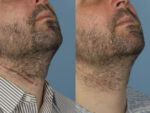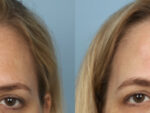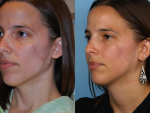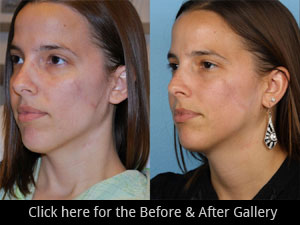Unsightly facial scars may be the result of previous trauma, acne, infection or surgery and are treated in a number of ways. Generally, a scar is unsightly because it does not blend in well with the surrounding skin. Pigmentation irregularities, abnormal directions, texture and elevation problems all make a scar more noticeable.
Results of Scar revision procedure
In a Scar Revision Procedures, some scars may be removed in their entirety and re-sutured in a controlled and precise manner. Other scars may not be easily removable, but their appearance can be significantly improved through other techniques. In these cases, scars can be made to appear less pigmented, smoother, thinner, and more easily hidden with make-up.
Depressions in the skin such as those caused by acne scars can be excised, re-closed, and then later dermabraded to become nearly undetectable. Alternatively, these areas may be filled in with an injectable or implantable filler material (see below). Large scars, contracted scars, or scars that pull structures of the face in an unfavorable way may be treated through techniques that change the position or orientation of the scar. This may result in the scar becoming hidden by the normal structures of the face or falling into normally appearing lines or wrinkles. Dermabrasion and Laser Resurfacing are also good options.
Dr. Sidle provides thorough consultations, including before and after pictures, to help patients understand the potential outcomes of scar revision procedures.
There is certainly an art to scar revision. The exact technique used and the success of scar revision depends on many factors—the scar’s size, shape, and location as well as the patient’s age, heredity, and general skin condition. Dr. Sidle has extensive experience with scar revision surgery and tries to help his patients with scars understand all of the possible options so that they can make an informed choice.
There is very little discomfort associated with scar revision. All procedures require that direct sun exposure be avoided so that permanent abnormal pigmentation will not occur. The use of sunblocks and avoidance of the sun for at least three months is imperative to avoid pigment discoloration.
Collagen Injections can be used to fill out depressed or hollowed-out scars. Collagen is a natural animal protein that blends well with existing skin tissue. Collagen, however, is not permanent and may need periodic re-injections. Other filler options include Ultrasoft®, Restylane®, Sculptra®, Alloderm®, and fat injection.
How much does it cost to remove a scar?
It depends on the size and severity of the scar. Generally, it costs anywhere from $100 to $200 to remove a scar. Some factors affecting the scar removal cost include the type of treatment used, whether surgery is required, and the scar’s area. Insurance may cover some or all of the cost of treatment for scars that are considered medically necessary.
What is the recovery time for a Scar Revision?
Scar revision surgery typically requires about two weeks for healing and recovery. However, the time needed for recovery varies depending on the individual and the extent of the surgery. Generally speaking, most people feel comfortable returning to work after two weeks. More strenuous activities may need to be avoided for a few more weeks. Patients should follow their doctor’s instructions for healing and recovery closely to ensure a smooth and speedy recovery.
Why Prefer Dr. Sidle For Scar Revision In Chicago?
Experience Matters. As a board certified Facial Plastic Surgeon at Northwestern with expertise in the face and neck, Dr. Sidle can provide you with an individualized plan to achieve your goals of a more youthful face. Call our office for a one-on-one consultation.
Scar Revision FAQs
The surgery time for scar revision will depend on the extent and complexity of the revision surgery. Most scar revisions can be completed in about one to two hours. However, more extensive revisions may take longer.
Yes, scar revision is often a covered procedure by insurance. Most health insurance plans will cover at least some of the costs associated with scar revision surgery. It’s important to speak with your insurance provider to determine exactly what is and isn’t covered. You may also be reimbursed for some of the costs associated with surgery if you have a flexible spending or health savings account.
Most scars will fade over time and become less noticeable. However, if you are not happy with the appearance of your scar, you may want to consider scar revision surgery. Scar revision surgery can be performed on any scar, including hypertrophic scars and keloids.
It depends on the scar’s size, depth, and severity. Generally, it takes anywhere from 3 to 6 sessions to remove a scar. However, more severe or older scars may require more sessions for optimal results.
A healed scar should look like normal, unblemished skin. The scar’s color will likely differ from the surrounding skin, but it will not be raised or lumpy. If a scar is adequately healed, it should not be noticeable or cause any discomfort.
Yes. Old scars can be treated with various methods, including surgery, laser therapy, and chemical peels. There are many different methods for treating scars; each patient will respond differently to different treatments. Surgery is often used for deep or large scars, while laser therapy and chemical peels are typically used for smaller or newer scars. Treatment plans should be tailored to the individual.
The best time for scar revision surgery is typically 6 to 12 months after the initial injury. This allows the wound to heal completely and your surgeon to accurately assess the scar.
No. Scar revision surgery is a relatively minor procedure generally performed on an outpatient basis with local anesthesia. Most people report that the pain associated with scar revision surgery is minimal. Occasionally, discomfort may be present for a few days following the surgery. However, this can be easily managed with over-the-counter pain medication.
Post-Operative Instructions
All post-operative instructions can be found on the Patient Resources page.
Our Results
Click here to access our Before and After gallery for all procedures.






